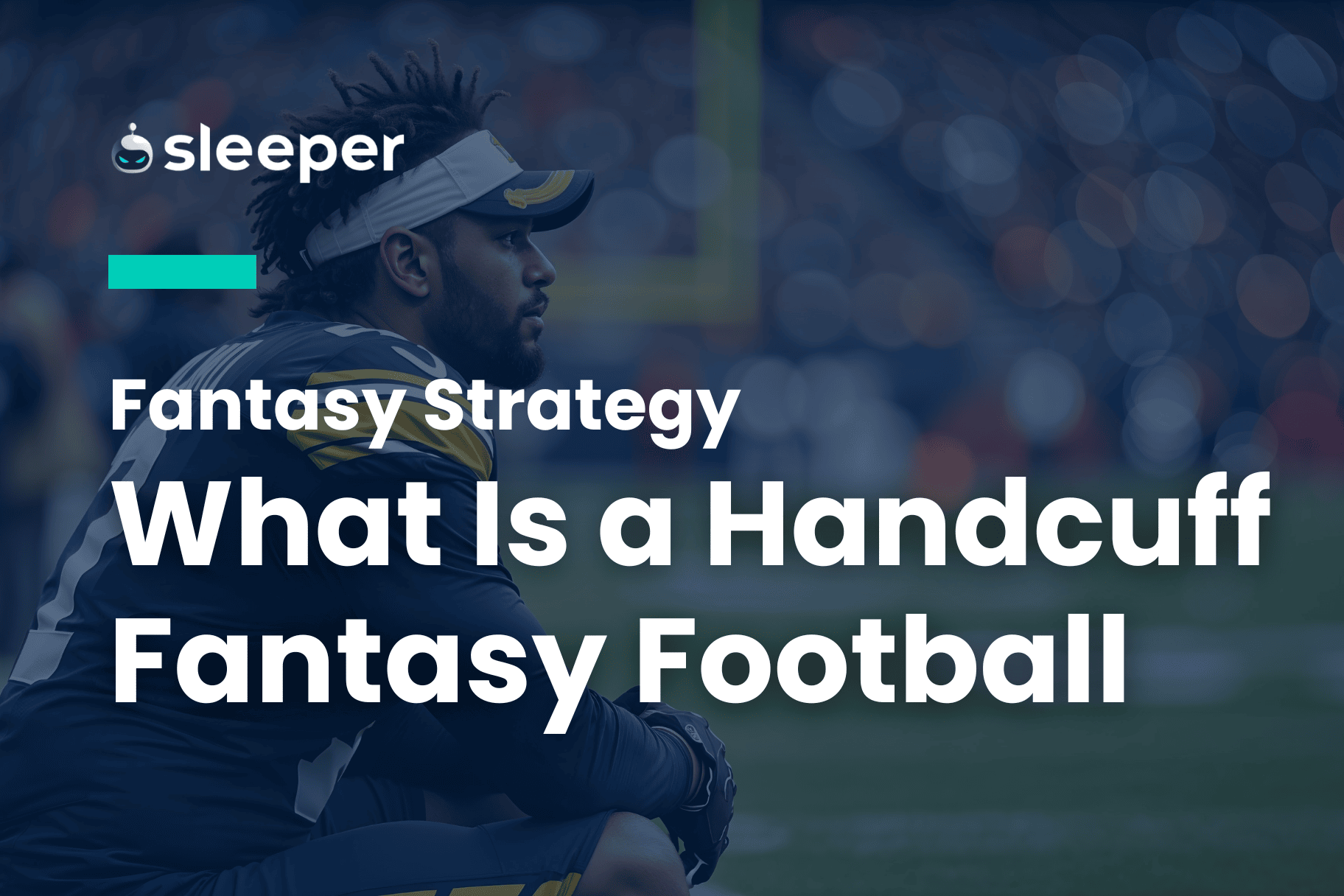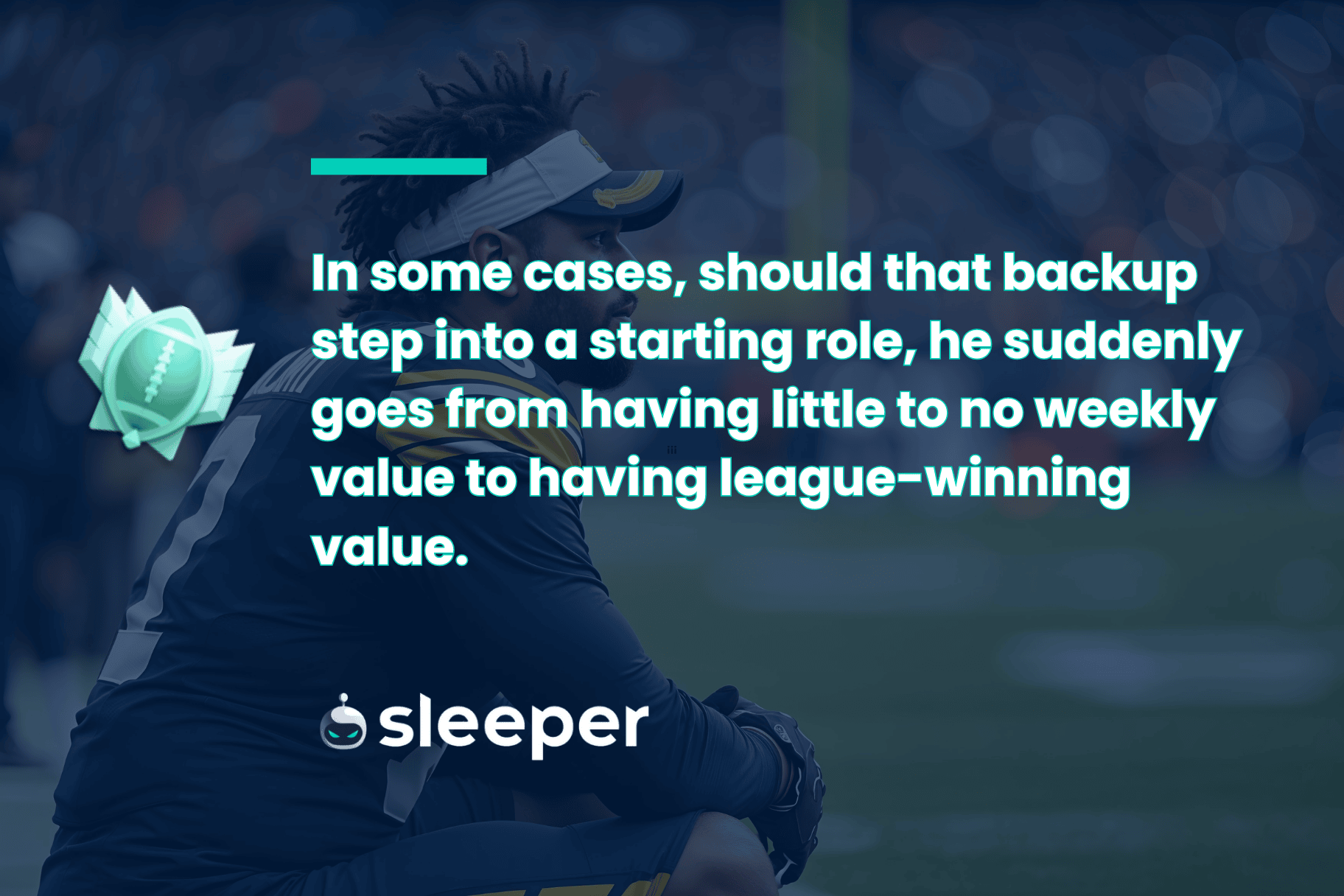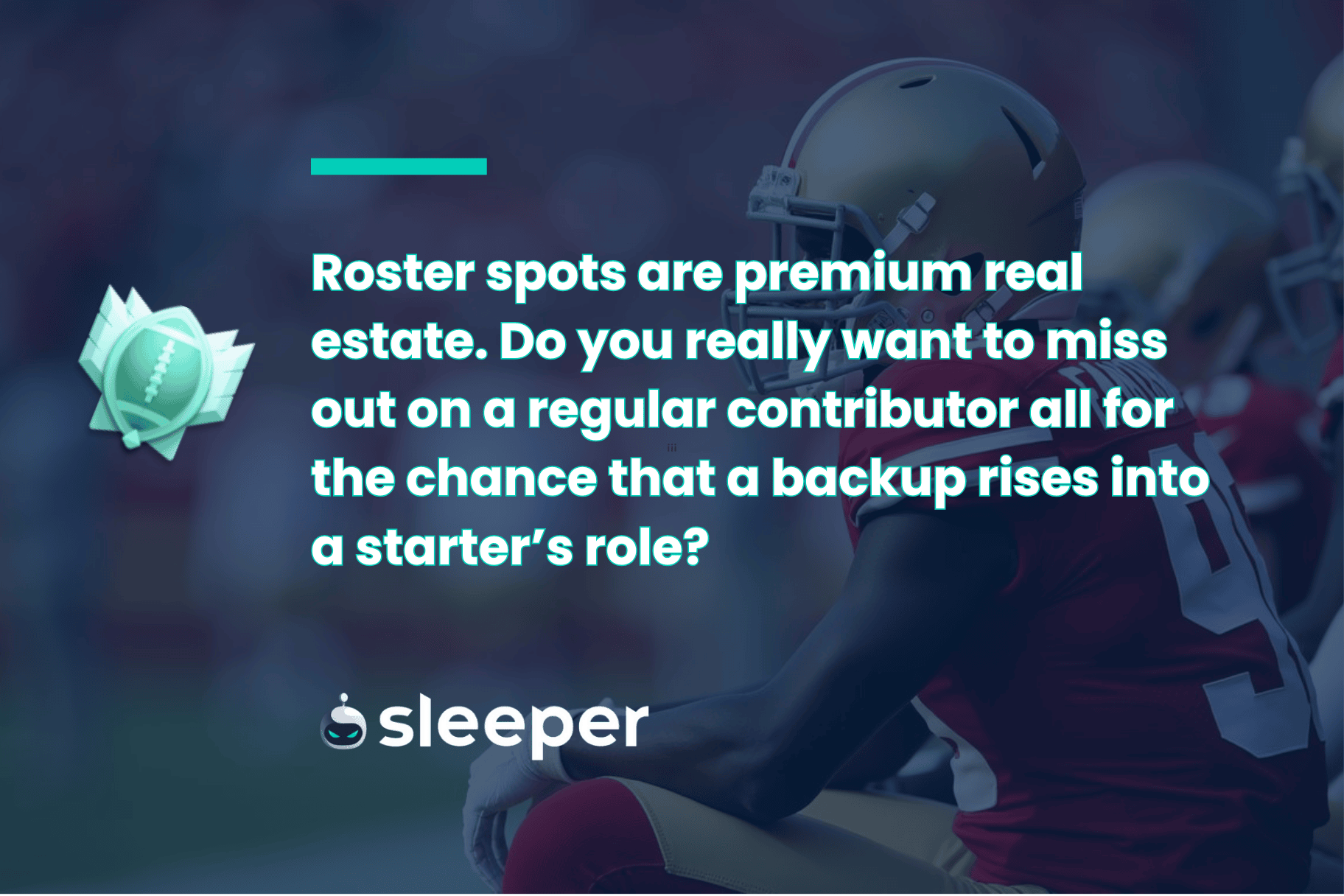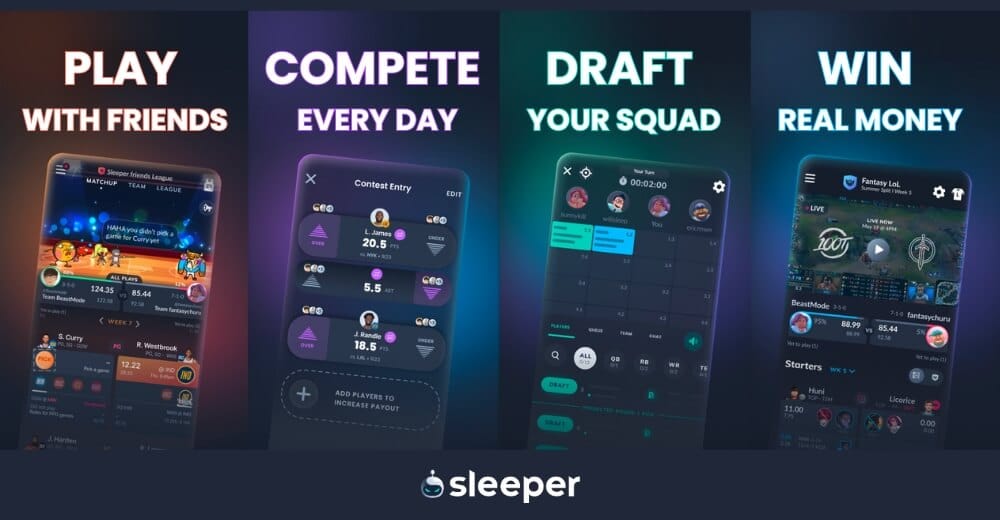When drafting or managing a season-long fantasy football team, understanding how to use a “handcuff" could make or break your season.

What a Handcuff Is in Fantasy Football and Best Strategy
Injuries are big part of real football and a huge part of fantasy football, too. You can have the world’s greatest draft, but if your studs go down and you don’t have a backup plan in place, your season runs the risk of going down in flames.
That’s where handcuffs come in. They don’t always pan out and aren’t always needed. In many cases, they could hamstring your roster, but they’re also the insurance policy that could potentially save your season.
What Is a Handcuff in Fantasy Football?
A handcuff is the real-life backup who stands to step into a major fantasy spotlight in the event of injury or suspension to the starter. He is often a player who is drafted by fantasy managers in conjunction with that starter to provide immediate lineup insurance.
In some cases, should that backup step into a starting role, he suddenly goes from having little to no weekly value to having league-winning value.
A handcuff is more than just a second string player. A handcuff is a fantasy football insurance policy in the event one of your best players goes down with a season-threatening injury.
Drafting a handcuff doesn’t come without risk, though. That player takes up valuable roster space (and a draft pick) while offering no immediate scoring punch to your team. You’re almost certainly not going to start the player unless the opportunity he’s waiting for opens up, and that might not ever happen. In one sense, drafting handcuffs (either for your own starters or for those of your opponents) is a bit of a lottery ticket. You’re hoping it comes through, and if it does you win big, but there’s far from a guarantee.

Handcuffs technically can be applied to any position, but the term is most commonly used when referring to running backs. There’s ample reason for that.
Reserve quarterbacks aren’t usually as explosive as the players they’re backing up, and unless you’re in a superflex league, there are almost always better, streamable QB starters available on the waiver wire.
Wide receivers aren’t all apples-to-apples. If a big-play wideout goes down, his targets could be spread to different players all over the field. Plus, his backup might not be as sure-handed or dynamic. There’s also a large pool of WRs to pick from, and while opportunities could be had for a direct WR backup, drafting handcuffs at that position is very rarely a season-changing strategy.
The same goes for tight ends, where the pool of viable starters is thin enough as is. The idea of drafting one team’s backup TE is a rather low-reward proposition.
That leaves running backs, where carries — especially on the goal line — and targets can be fantasy gold, and when there’s a 15- or 20-carry-per-game gap in an offense, it’s usually down to one player to fill the void.
4 Tips to Use the Handcuff Strategy
When thinking about handcuffs as you prepare to draft, mull over the following to help plot out your approach:
1. Consider the risks of using the handcuff strategy
Roster spots are premium real estate. Do you really want to miss out on a regular contributor all for the chance that a backup rises into a starter’s role? Do you want to avoid picking up a potential waiver-wire stud because you’re married to the idea of having one of your starters’ direct, high-ceiling backups and don’t have the roster space to make it happen otherwise? You likely don’t want to pass on more of a sure thing for more of an uncertain commodity.
2. Consider who is the backup and why are you choosing them
Just because a player is stepping into a starting role does not make that player fantasy gold. The situation has to be right, the workload has to be there and the player has to actually be, you know, good at football. There’s a reason these players are backups to begin with. Beyond that, sometimes the fantasy community (and experts) are wrong about which backup steps into the greater role, too.
3. Consider rostering your main competition's handcuff
Handcuffs are not just a safety valve for your own team's performance. They can also be used as a weapon to deliver a crushing blow to another team. If a leaguemate's top RB goes down and you have his handcuff, you not only improve your team's chances of success, but also deny your opponent a significant source of fantasy points.
4. Use other managers’ handcuffs in trade talks
Handcuffs can provide value to your team beyond the scoreboard. If you see another manager has become vulnerable due to a starter’s injury, and if you have ample depth at that position, consider trading that manager the handcuff he or she is yearning for as a way to strengthen the other parts of your roster.

4 Best Fantasy Football RB Handcuffs for 2024
For the purposes of this article, handcuffs will refer to clear backups and not players who are in a 1A-1B kind of timeshare. Of course, should anything happen to the 1A in that pairing, then the 1B would be poised for massive numbers and a huge workload (and vice versa).
But, for example, Detroit’s Jahmyr Gibbs and David Montgomery were both among the top 20 RBs taken according to Sleeper ADP (redraft PPR) and were drafted to be fantasy starters. They don’t fit the true spirit of the handcuff. As for those who do:
Blake Corum, Los Angeles Rams
The rookie out of Michigan would stand to benefit greatly if anything were to happen to Kyren Williams in a very run-friendly offense.
Tyler Allgeier, Atlanta Falcons
Allgeier has already notched a 1,000-yard season as a starter, and he maintained a steady role in 2023 despite Atlanta drafting Bijan Robinson. Should injury occur and Allgeier become starter again, he’d slide seamlessly into a blowup spot.
Zach Charbonnet, Seattle Seahawks
The second-year back already has a regular role behind Kenneth Walker III. He was targeted 40 times out of the backfield and averaged 4.3 yards per carry as a rookie and should only get better.
Ty Chandler, Minnesota Vikings
Chandler already showed his quality in spurts last season, notching double-digit carries in six of Minnesota’s last eight games of the season and securing three or more targets in five of those games. Aaron Jones may have been signed away from rival Green Bay to start, but he hasn’t exactly been a picture of perfect health, either.
3 of the Best Handcuffs in Recent Fantasy Football History
DeAngelo Williams, 2015
Largely known for his time as a Carolina Panther, Williams made the most of his first season with the Pittsburgh Steelers by filling in for Le’Veon Bell. The first two weeks of the season were expected, with Bell out suspended. But when the mercurial back went down in Week 8 with a knee injury, Williams seized his chance.
Williams finished 2015 tied for the league lead in rushing TDs (11) and an RB6 finish in PPR scoring. And in the week that would have been most leagues’ championship games, he ran for 100 yards and two touchdowns, while catching six passes for 53 yards.
James Conner, 2018
Once again, Bell’s inability to play — this one a self-inflicted and poorly executed season-long holdout — opened the door for a handcuff to star. Bell was widely being drafted as a top-three pick in 2018. Conner was going roughly 13 rounds later. And yet it was the latter who started all season, rushing for 973 yards and 12 TDs, while catching 55 passes for 497 yards and another TD. A brutally timed high-ankle sprain crushed fantasy owners for the playoffs, though.
Phillip Lindsay, 2018
The player Lindsay supplanted, fellow Denver Broncos rookie Royce Freeman, wasn’t exactly a sure-thing stud entering the season, but he was generally drafted as in the RB15-20 range, while Lindsay was hardly drafted at all. He emerged as more than just a typical handcuff with an unexpected showing in Week 1, and he parlayed it into nearly 1,300 rushing and receiving yards and 10 total touchdowns. He wasn’t even anticipated to be the Broncos’ top backup (Devontae Booker was supposed to be the guy), but he literally ran with the opportunity — and likely delivered fantasy titles to those who were in on him early.
Frequently Asked Questions
Should you handcuff your running backs?
Not necessarily. Like any insurance policy, it’s great to have when you really need it. But, in fantasy football context, not at the expense of a significantly more consistent player who is more of a lock to help your squad. It’s convenient to have a player’s backup ready to go in the event of an injury and saves you the headache of finding an alternative solution, but there’s also no guarantee that the backup produces at a starter level.
How does a handcuff work in fantasy football?
If you’ve drafted one a player, generally a running back, to be a starter, you ensure that you’ll at the very least have his workload covered in the form of his backup by drafting that player, too. After the starter goes down, slot the backup into his place in your lineup, and you’re good to go.
Who is Christian McCaffrey's handcuff?
The San Francisco 49ers star was regularly taken as the No. 1 pick in redraft fantasy leagues over the past couple seasons, and for good reason. He’s a scoring machine and a regular target hog out of the backfield, too. But if he goes down, Elijah Mitchell and Jordan Mason are next up to take on his workload.
Try Your Hand With Sleeper
Handcuffs can be useful, but they’re far from a must-have depending on the setup of your fantasy league and the size of your rosters. You can test out handcuff strategy through countless mock drafts on Sleeper and then put your research to the test by signing up for season-long leagues either via the website or by downloading the app.
Sleeper offers a unique experience with many customizable features for you and your leaguemates to explore. Sleeper is also the best DFS platform to play weekly games throughout the season, which you can test out via Sleeper Picks and Daily Draft — in case your handcuff strategy goes south and you still want to compete week-in and week-out.




